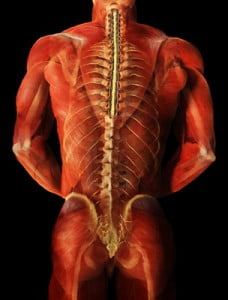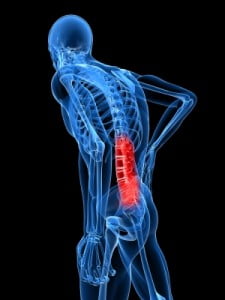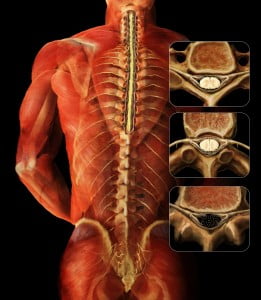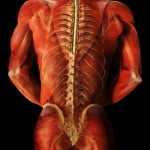 I met a lovely 53 year old gentleman, who was suffering from severe low back and hip pain for over a year, diagnosed with a herniated disc. He had tried physical therapy with some relief, but still was unable to eliminate his pain. After diagnosing and treating muscles in his low back, buttock, and thigh, he reported no low back pain, and was discharged from our office. However, after five years, he returned to our office, stating that he had foot pain, diagnosed with plantar fasciitis, and unable to rock climb or hike without severe pain in his calves and feet. After identifying and treating multiple muscles in his calves, shins, and feet, he reported 100% relief, and even finished a 10 day rock climbing trip. Although you may be given one diagnosis, sometimes we find muscle involvement and are able to eliminate the pain!
I met a lovely 53 year old gentleman, who was suffering from severe low back and hip pain for over a year, diagnosed with a herniated disc. He had tried physical therapy with some relief, but still was unable to eliminate his pain. After diagnosing and treating muscles in his low back, buttock, and thigh, he reported no low back pain, and was discharged from our office. However, after five years, he returned to our office, stating that he had foot pain, diagnosed with plantar fasciitis, and unable to rock climb or hike without severe pain in his calves and feet. After identifying and treating multiple muscles in his calves, shins, and feet, he reported 100% relief, and even finished a 10 day rock climbing trip. Although you may be given one diagnosis, sometimes we find muscle involvement and are able to eliminate the pain!
Archive for 'back pain'
How important is your diagnosis?
The Start of Baseball Season
The baseball season just opened and already players are calling off their first few games due to “tweaked knees” and “sore backs”. As the sun is starting to come out, and the snow is (FINALLY!) melting, many of us are anxious to get outside and start playing sports again. However, this is also a time where pain can start rearing its ugly head. Many people forget to limber and stretch properly before AND after playing sports, causing strains and sprains of muscles.
So keep in mind these important tips to get moving again this spring:
- Do gentle limbering stretches every day to help maintain flexibility of your muscles.
- Stretch before and after any exercise.
- Start slowly – if you haven’t moved all winter, start with simple exercises, like walking, before starting anything more difficult.
- If you’re feeling extremely sore the following day, it means you may have done too much. Cut back on the difficulty and amount of time the next time you exercise. Slowly increase the difficulty and the length of the session. A safe rule of thumb is to start out after a long layoff at 50% of your prior routine and then increase 15-20% every 5-7 days as long as you feel okay at any level before going to the next.
- Drink lots of water!
Smoking and Back Pain – is it related?
We all know that smoking is bad for you. In fact, since 1965, the Surgeon General’s Warning posted on every package of cigarettes says: Smoking Causes Lung Cancer, Heart Disease, Emphysema, And May Complicate Pregnancy. But did you know that in addition to the myriad of illnesses that are related to tobacco and smoking, recent studies show that smokers have a higher prevalence of back pain than non-smokers? It’s true.
Several studies in the 1980s and 1990s have shown a correlation between smoking and increased back pain. More recently, a  meta-analysis was done in 2010, which basically means a large number of studies (in this case, 40) were put together, and the results were compared to see what pattern, if any, existed between back pain and smoking. This meta-analysis concluded that current and former smokers have a higher prevalence of back pain. It even made the comparison between adult smokers to adolescent smokers; adolescents showed a higher prevalence of back pain. Therefore, we can conclude, the earlier one smokes, the greater risk to your back.
meta-analysis was done in 2010, which basically means a large number of studies (in this case, 40) were put together, and the results were compared to see what pattern, if any, existed between back pain and smoking. This meta-analysis concluded that current and former smokers have a higher prevalence of back pain. It even made the comparison between adult smokers to adolescent smokers; adolescents showed a higher prevalence of back pain. Therefore, we can conclude, the earlier one smokes, the greater risk to your back.
Is there a technical or medical reason behind this connection? Indeed. Smoking causes constriction of blood vessels, which reduces the amount of blood going to your muscles. Decreased blood results in decreased oxygen, which is one of the most important factors in initiating muscle pain. Some smokers actually had parts of their arms and legs amputated because of dead tissue caused by too little oxygen.
Do you want be free of back pain? Put out that cigarette and quit smoking!
When Making Medical Decisions About Pain Relief, Is More Information Better?
In today’s world we are bombarded by information and ways to obtain it. Do you want to know how many steps you take a day? Just buy a device and it will calculate it for you. Care to know what your cholesterol levels are? Simply go get a kit at your nearest drug store. Is it possible we are gathering too much information for our own good?
The same question can be asked about medical testing. Is it useful or even helpful to know certain things about our bodies? Many of us have undoubtedly had the experience where we have gone to the doctor because we had pain and an imaging study was ordered. MRI, CT, and ultrasound can give us information about our bodies that would have been unimaginable in the past.
While technology in general is of course a huge benefit, at the Norman Marcus Pain Institute, we believe it is necessary to proceed with caution as we navigate through it all. At NMPI, one common problem we find in back pain, neck pain, and shoulder pain is the overuse and overreliance on imaging studies. “Abnormalities” are often found on imaging studies without any relation to one’s pain. In fact, seeing abnormalities is more common than seeing a “normal” spine! For example, up to 40% of people without back pain can have herniated discs and as many as 70% may have degenerated discs. That is why the US Institute of Medicine suggests not getting an MRI too quickly since you are likely to see one of these problems and assume it is the cause of your pain. This can lead to unnecessary nerve blocks and surgery.
herniated discs and as many as 70% may have degenerated discs. That is why the US Institute of Medicine suggests not getting an MRI too quickly since you are likely to see one of these problems and assume it is the cause of your pain. This can lead to unnecessary nerve blocks and surgery.
At NMPI, we often see patients who have a herniated disc, yet they only have pain in their back and buttock. They have not experienced any radiation into the leg(s) at all. In these patients, the pain generally has nothing to do with the disc herniation since disc herniation pain generally radiates down the leg and into the foot. Even when the patient is experiencing pain down the leg with a herniated disc found on MRI, muscles in the low back and buttocks may be the cause of the pain. If muscles are not examined as a potential cause, you may undergo an apparently reasonable surgery, without achieving relief of pain. Some studies show that up to 50% of spine surgeries fail (resulting in failed back surgery syndrome) and one of the reasons is the failure to identify muscles that were the true source of the pain.
Most back pain and neck pain is caused by soft tissue such as muscles and tendons. This is confusing because you may have been told your pain is from your spine, discs, or nerves. The problem is most people as they get older have signs of wear and tear on their x-rays and MRIs, but these common signs of aging may not explain your pain if the pain actually originates in your muscles. That’s why we say, when diagnosing persistent pain it’s not having “more” information at hand, it’s having the “right” information at hand.
At NMPI, we often see patients who experience persistent pain even after multiple spine surgeries. Our non-surgical, non-invasive treatment program has most of our patients leaving our office free of long standing back, neck, shoulder, and headache pain.
Why Health Insurances Carriers Should Not Be For Profit Enterprises
In November, I read this article in The New York Times on How Medical Care Is Being Corrupted. In a nutshell — Insurance carriers have been incentivizing care for more than 20 years by selectively paying for some services whilst denying others.
To successfully address a complicated problem, such as long-standing pain, more than one approach is often most effective albeit initially more expensive. As a Pain Medicine physician, I have witnessed the defunding of the only approach that has been found to be consistently successful (by the Cochrane database for systematic reviews) in addressing patients disabled by chronic back pain: comprehensive multidisciplinary pain treatment centers.
While cost should be a consideration in choosing treatment – it should not be the primary deciding factor. For-profit insurance companies can be effective in helping policyholders fund their medical care but they are constrained by conflicting interests
- A moral and ethical obligation to care for policyholders who have purchased a policy to protect their health.
- Shareholders who have invested in the company and expect each quarter to produce a reasonable profit.
If you believe, as I do, that health insurance not be allowed to be a for profit enterprise, join in a national discussion to legislate that all health insurance be not-for-profit. Insurance companies should only exist for the protection of the individual patient.
Rafael Nadal will receive stem cell therapy for back pain – Should You?
Earlier in November, Rafael Nadal, the 14-time Grand Slam winner, announced he would receive stem cell treatment to help heal his ailing back, the same type of treatment he received for his knee. His doctor in Barcelona, Dr. Angel Ruiz-Cotorro, who has been treating Nadal for 14 years, said, “Nadal’s back pain is ‘typical of tennis’ players in that the treatment is meant to help repair his cartilage.” Stem cells were recently extracted from Nadal for a cultivation process to “produce the necessary quantities,” said Ruiz-Cotorro. Once cultivated, the stem cells will be placed into the joints of his spine with the goal of regeneration of cartilage as well as for an anti-inflammatory effect. Dr. Ruiz-Cotorro predicts that Nadal can return to training in early December.
Will stem cell treatment work for Nadal’s Back Pain?
Stem cell treatment may seem logical in certain situations – for example, if you have a mechanical problem where a knee has worn out cartilage, causing bone to rub against bone, it makes sense to use stem cells to grow new cartilage to have a cushion to protect the bone and cause the knee to be less painful. As much as we may want to see him back on the courts  grabbing more grand slam titles, if Nadal’s stem cell treatment is being used to eliminate his pain by repairing his joints or discs, the actual cause of his back pain may not be addressed.
grabbing more grand slam titles, if Nadal’s stem cell treatment is being used to eliminate his pain by repairing his joints or discs, the actual cause of his back pain may not be addressed.
Where does back pain originate?
The number one reason for back pain is muscular and other soft tissue, yet muscles are rarely evaluated as the cause of back pain. The only way to determine if Nadal’s back pain is from soft tissue and similar to most people with back pain would be a physical examination of Nadal’s back that included identifying possible muscles as the cause of his pain.
Some doctors believe that the disc, the cushion between the bones of the spine (the vertebra), is a major cause of back pain. They believe that surgeries to correct the flattening or herniation of the disc will decrease or eliminate back pain. Sometimes they are right, but they are just as likely to be wrong. The truth is that there is as high as a 50% failure rate for spine surgeries that were done to eliminate back pain thought to be related to disc problems. There are other joints in the spine that are thought to cause pain; one of them is the facet joint, which could also be a target for stem cell treatments.
When doctors rely on an MRI or CT scan to determine the source of the pain, the information obtained is often confusing. If a surgeon sees an abnormality on an MRI, he will often point to that abnormality as the cause of the pain; in my experience the abnormality found on an MRI or CT scan frequently is not the cause. In fact, if you randomly selected 100 people off the street, and perform an imaging scan, 40 may present with a herniated disc and have no pain and absolutely no awareness of their herniated disc; 70 may have degenerated (worn) discs with no pain, and a large number will have facet joint abnormalities. Therefore, finding an “abnormality” is more common than not. One, then, can deduce that the abnormality is more likely NOT the source of the pain. So treating the abnormality (with steroid injections, surgery, or stem cells) may therefore not relieve the pain.
Stem Cell Treatment and Sports Stars
Nadal, currently ranked as the number 3 professional tennis player in the world, is not the first sports star to chase after a “miracle cure.” The Denver Bronco quarterback Payton Manning and Yankees pitcher Bartolo Colon both went abroad to seek out stem cell treatment as a quick fix to get back in the game. (They both seem to be doing better overall, but it is inconclusive if the stem cell treatment was the cause of their recovery).
Will it work?
In the laboratory, it has been possible to demonstrate the ability of stem cells (most commonly found in the developing embryo and newborn) to grow new tissue. These cells are like silly putty; they can turn into, or adapt, to become any type of tissue. For example, a stem cell in the right environment in the body could become bone, cartilage or some organ (for example, liver or pancreas). But, it hasn’t been as easy to grow tissue in an actual person. There are some early studies that show that stem cells “may” relieve back pain, but both the doctors who are testing the technique and outside experts say much more research is needed before they can say whether the treatment offers real relief.
The use of stem cell therapies continues to be a hot topic for debate in the sports medicine and orthopedic surgery worlds. There is no current evidence-based research to prove that it works.
Sir William Osler, a famous physician, once said: “Use every new treatment as quickly as possible before it stops working.” Stem cell treatment needs to be further investigated to determine if stem cell treatments indeed work, and if so, for what conditions?
Epidural steroids are not effective for spinal stenosis
I have been suggesting for many years that there is an overuse of spinal injections and surgeries for low back and leg pain, so it was no surprise when I read an article in The New York Times (NYT) that reported on a study recently published in the New England Journal of Medicine[1] about patients with spinal stenosis who are frequently treated with a procedure that has been shown to be ineffective. Epidural steroid and lidocaine injections for patients found to have spinal stenosis were no better than epidural injections of lidocaine alone. In chapter 4 of my book End Back Pain Forever I discuss the many reasons for back pain. MRIs and CT scans of the low back will almost always find something such as spinal stenosis or a degenerated or herniated disc even in patients without pain. Therefore the US Institute of Medicine suggests that these imaging studies should not be done routinely since what you find in the study is frequently not the cause of your pain. The most common cause of back pain is muscles and other soft tissue. If you treat the diagnosis you got from the MRI or CT and the actual reason for the pain is muscle, it makes sense that the treatment will frequently fail, which it does!
The NYT report of this relatively large, randomized, double blind, controlled study clearly demonstrates the ineffectiveness of the use of steroids for symptoms attributable to spinal stenosis (narrowing of the canal in the spine which contains the spinal cord) which occurs frequently as we age. The treatments most often provided are epidural steroids to theoretically reduce the inflammation of the nerves being squeezed by the narrow canal, and surgery to widen the canal. Both approaches have a significant failure rate.
At the Norman Marcus Pain Institute we have shown in multiple published articles that one reason why these approaches are ineffective is that the pain in the back and leg may not be the result of the narrowing or other supposed abnormalities seen on the MRI or CT scan. It is well known that very few (in one published article- less than 10%) scans of the low back in adults are read as normal; as many as 40% of adults with no back pain have herniated discs, and 70% have degenerated discs. So it is “normal” to find an abnormality.
Our unique physical examination, utilizes an instrument I developed, reveals that many patients with back and leg pains have areas of muscle tenderness that are the source of their pain yet are overlooked. One study of more than 23,000 patients[2] found that 70-80% of patients with back pain were diagnosed with sprains and strains of muscle and other soft tissue. It’s hard to believe then, armed with this knowledge, that muscle examination and treatment is not part of the typical standard of care for back pain in the USA[3]. If we are to properly address the cause of most back pain, the evaluation and treatment of its muscular causes must be addressed.
[1] Friedly JL, Comstock BA, Turner JA, et al. A Randomized Trial of Epidural Glucocorticoid Injections for Spinal Stenosis. New England Journal of Medicine. 2014:374:11-21.
[2] Deyo RA, Weinstein JN. Primary care – low back pain. New England Journal of Medicine. 2001:5:363-70.
[3] Chou R, Qaseem A, Snow V, Casey D, Cross JT, Shekelle P, et al. Diagnosis and Treatment of Low Back Pain: A Joint Clinical Practice Guideline from the American College of Physicians and the American Pain Society. Ann Intern Med. 2007;147:478-491.
Stiffness is an important aspect of muscle pain
I recently saw George, a 48-year-old man, who suffered from pain, described as soreness in the thighs, neck, shoulders and arms, and tingling in his calves and shin. Sitting for more than two hours or sitting for more than 20 minutes would cause an increase in his pain. Bending over also brought on his pain.
George had tried physical therapy on multiple occasions, and saw two neurologists, who could not find anything that would explain his pain.
When I examined him, I found him to be strong but very stiff. When he bent over, he was able to reach within 14 inches of the floor. When he lied on his back and lifted one leg up at a time, he was able to reach only 57 degrees (85 75 degrees is normal). Because he was so stiff, I decided to start a course of exercises that would help increase his range of motion.
Over the next few weeks, George learned all 21 of the Kraus-Marcus exercises, which he was advised to do every day. As he did the exercises, he noticed that his pain level was decreasing and wasn’t occurring as often as usual. When he was taught the last 7 exercises, he was able to bend over to within 9 inches of the floor, and could lift each leg to 80 degrees.
A month later, George reports a 90% decrease in his overall pain. Sometimes we find that starting with the most conservative of treatments can prevent us from performing more costly and dangerous treatments. Very often, stiffness is an important aspect of one’s pain that can easily be found and treated!
Low Level Laser Therapy as promising treatment
Low level laser therapy (LLLT) is a promising new treatment for a variety of painful conditions which is believed to reduce inflammation and stimulate healing of wounds. Interest in the laser first developed when Endre Mester at Semmelweis University noticed that applying the laser to the backs of shaven mice caused hair to regrow faster than those who did not receive laser treatment.[1] This observation prompted further study into the regenerative effects of the laser first in rats, and then later in humans.
Currently, there aren’t many large-scale studies evaluating the effectiveness of the laser, but smaller studies of the laser for painful conditions show promising results.
A study of 50 patients with knee osteoarthritis reported that the laser was significantly more effective at providing pain relief than transcutaneous electric nerve stimulation (TENS)**.[2] Similarly, a separate study of 125 patients with knee osteoarthritis reported both an improvement in pain and an increase in function after LLLT.[3]
In a study of patients with temporomandibular disorders, the laser improved pain within 24 hours, with relief lasting at the 180 day follow-up.[4]
Current studies show that the laser is an up and coming, non-invasive, non-painful treatment option, but larger studies are needed to determine the correct dosing, and for which conditions the laser will be most useful.
**TENS (transcutaneous electrical stimulation) – electrodes are applied to the skin, sending an electric current to the nerves in the skin. The nerves then transmit a signal to the brain. This signal is competing with the signal coming from your painful area. So, instead of feeling your normal pain, you’ll feel a buzzing sensation where the electrodes are attached.
[1] Chung, Hoon, Tianhong Dai, Sulbha K. Sharma, Ying-Ying Huang, James D. Carroll, and Michael R. Hamblin. “The Nuts and Bolts of Low-level Laser (Light) Therapy.” Annals of Biomedical Engineering 40.2 (2012): 516-33. Print.
[2] Kędzierski, Tomasz, Katarzyna Stańczak, Kamila Gworys, Jowita Gasztych, Marcin Sibiński, and Jolanta Kujawa. “Comparative Evaluation of the Direct Analgesic Efficacy of Selected Physiotherapeutic Methods in Subjects with Knee Joint Degenerative Disease – Preliminary Report.” Ortopedia Traumatologia Rehabilitacja 14.6 (2012): 1-10. Print.
[3] Gworys, Kamila, Jowita Gasztych, Anna Puzder, Przemysław Gworys, and Jolanta Kujawa. “Influence of Various Laser Therapy Methods on Knee Joint Pain and Function in Patients with Knee Osteoarthritis.” Ortopedia Traumatologia Rehabilitacja 14.3 (2012): 269-77. Print.
[4] Pereira, T. S., O. D. Flecha, R. C. Guimaraes, A. M. Botelho, JC Ramos Gloria, and K. T. Aguiar Tavano. “Efficacy of Red and Infrared Lasers in Treatment of Temporomandibular Disorders–a Double-blind, Randomized, Parallel Clinical Trial.” Cranio : The Journal of Craniomandibular Practice 32.1 (2014): n. pag. Ovid. Web.
NSAIDs for pain relief
The next series of blogs is a brief discussion of different types of medications used for pain.
NSAIDs
Non-steroidal anti-inflammatory drugs (NSAIDs) are generally one of the first line of medications used in the initial treatment of pain. They are exactly what their name means – they are not steroid medications (like cortisone or prednisone) and they reduce inflammation which is the body’s response to any damage from any cause. When inflammation occurs there is pain along with redness, swelling and heat, which are collectively known as the cardinal signs of inflammation. Examples of NSAIDs are ibuprofen (Advil/Motrin), naproxen (Naprosyn), meloxicam (Mobic), and diclofenac (Voltaren). Aspirin is similar to the NSAIDs in almost every way but curiously it helps prevent heart attacks whereas NSAIDs may cause them (see below).
 Although NSAIDs have a number of side effects, the two most common are stomach irritation and an increased tendency to bleed. That’s why you are advised to eat when taking NSAIDs and why you have to stop taking NSAIDS before any type of intervention that may cause bleeding (such as injections or surgery). In order to decrease the side effect of stomach irritation, many have switched to a topical NSAID, most commonly diclofenac which is offered as a patch (Flector-patch) or gel (such as diclofenac or Voltaren gel). Other potentially serious side effects include kidney failure – if your kidneys are not working properly the NSAID can cause them to stop functioning, asthmatic episodes if you are prone to having asthma, and heart attacks if you have cardiovascular disease (heart disease, high blood pressure, history of stroke).
Although NSAIDs have a number of side effects, the two most common are stomach irritation and an increased tendency to bleed. That’s why you are advised to eat when taking NSAIDs and why you have to stop taking NSAIDS before any type of intervention that may cause bleeding (such as injections or surgery). In order to decrease the side effect of stomach irritation, many have switched to a topical NSAID, most commonly diclofenac which is offered as a patch (Flector-patch) or gel (such as diclofenac or Voltaren gel). Other potentially serious side effects include kidney failure – if your kidneys are not working properly the NSAID can cause them to stop functioning, asthmatic episodes if you are prone to having asthma, and heart attacks if you have cardiovascular disease (heart disease, high blood pressure, history of stroke).
Image courtesy of anekoho/FreeDigitalPhotos.net
Muscles as the source of pain
Muscles are the largest organ system in the body, accounting for approximately 50% of our body weight. We have different ways of categorizing muscles: how they look, how they move, and where they’re located. We are going to focus on muscles that move voluntarily, which means we tell the muscles to move, as opposed to involuntary muscles, which automatically move on their own (like our heart and blood vessels). There are 641 muscles in the body – 340 pairs (meaning we have one on the right, and one on the left), and one unpaired (which is the transverse arytenoid for those who must know).
70% of lower back pain is diagnosed as idiopathic or non-specific[1], which means we are not sure what caused the pain. However, most investigators believe that sprains and strains of the soft tissue are the source of pain. Soft tissue refers to muscles, tendons, and ligaments. So it may be surprising that the emphasis in evaluating and treating lower back pain, neck pain, and shoulder pain, is on the spine and the nerves coming out of the spine. In fact, from 1997 to 2005, the prevalence of the diagnosis of spine-related issues has increased 100% while the diagnosis of strains and sprains of soft tissue has gone down by 40%[2].
This is generally attributed to the increase in the use of high-tech imaging studies, such as MRI and CT scans. However, just because we have a clearer image of what’s going on inside of your body doesn’t mean that we have a clearer understanding of what’s causing your pain. More than 90% of lower spine MRIs exams in adults are abnormal[3]. Studies have found that up to 40% of people have herniated discs and as many as 70% have degenerated discs with no pain. If people can walk around with abnormal spines without pain, then this means that abnormalities in the spine aren’t always the cause of pain. Your diagnosis of a herniated disc, spinal stenosis, or spondylosisthesis may actually be unrelated to your source of pain.
Muscles are often ignored when it comes to diagnosing pain. I believe the reason is that we rarely evaluate muscles as a source of pain. We generally don’t learn about or understand how they work, what chemical changes take place inside, and how they produce pain (the pathophysiology). I would like to take the next few blogs to discuss how muscles contribute to your chronic pain.
Back and neck pain that starts in one specific area often spreads locally and sometimes to other regions
A number of my patients who have been struggling with pain management for more than a year may report that although their pain began in one specific spot, over time, it began to spread. Sometimes, over time, neck pain would involve the lower back pain as well. Many of these patients were thought to possibly have fibromyalgia syndrome and were given anticonvulsant or serotonin-norepinephrine reuptake inhibitors (SNRIs). The spread of pain may be from central sensitization (CS) (http://bit.ly/1aVsdg0, http://bit.ly/1bHgSDU). With some of these patients when the worst pain was treated and resolved from one area it could appear in another and muscles not recognized on the initial examination would now be found to be causing discomfort. This could be a function of diffuse noxious inhibitory control (DNIC) http://bit.ly/14Ac4GL,
These confounding problems appear to represent two opposing and confusing phenomenon: CS and DNIC [currently referred to as conditioned pain modulation (CPM)] (http://bit.ly/1aVuish). Do these issues enter into your evaluation and treatment protocols?
Flouting guidelines: Worsening Trends in The Management and Treatment of Back Pain
The study published in JAMA today demonstrated that from 1999-2010 in 3 key areas, guidelines for the treatment of back pain are being ignored:
- Use of recommended NSAIDs and APAP as first line drugs decreased by ~35% whilst not recommended opioid use increased by ~50%.
- Not recommended referral from PCPs to specialists for back pain increased by ~106%.
- Not recommended use of imaging increased ~50% for MRI and CT and for x-ray remained the same.
Is this a problem? If so, how should it be addressed?
Read more: http://bit.ly/13touQu
Many Back Surgeries Unnecessary
In the United States we are faced with the highest per capita health costs in the world. One would think that massive expenditures could provide the best care and treatment outcomes, but this is not the case. In many aspects the US is worse or no better than countries spending 50% of what we do on health care. One reason is that we often inappropriately provide costly evaluation and treatment interventions. We provide surgery too frequently on conditions that could be treated more cost-effectively. Having a step- care model (using the least invasive and potentially harmful, and most cost-effective approaches first) for various conditions would offer models of care for the majority of problems whilst still allowing for modifications in unusual circumstances. —Dr. Norman Marcus
By Ryan Sabalow
Some doctors estimate the national rates of unnecessary hysterectomies and back surgeries are even higher than the 25 percent cited by state health officials questioning the Redding area’s high rates of the procedures.
Dr. Ernst Bartsich, a clinical associate professor of obstetrics and gynecology at Weill Cornell Medical College in Manhattan, N.Y., said as many as one in three women in the U.S. has had her uterus removed by the time she’s 60. That number increases to one in two by 65.
Bartsich, an outspoken critic of what he calls the overuse of hysterectomies, said he believes that 85 percent of such procedures could have been avoided through less invasive methods, such as removing painful fibroid tumors from the uterine wall or through medication.
Read the rest of this entry
“Doctor, My Back is Killing Me!” – Chapter 1, Part 3 (#endbackpain)
In the last part of Chapter 1 from End Back Pain Forever, we turn to the story of “Stephanie”. Please review this blog for the complete chapters 1 and 2 from my book.
“Doctor, My Back is Killing Me!”, Part 3
Take the case of a patient whom I shall call Stephanie. She is a married attorney who in 2004 began to experience stiffness whenever she she got up out of a chair. She also had problems straightening up if she bent over. This was bothersome, but it was nothing compared to her first attack of spasms in her low back, on the right side. The spasms were incapacitating. She couldn’t walk and had to lie in bed for four days, taking painkillers and muscle relaxants. When the spasms broke, she still felt an inkling of discomfort that would frequently and unexpectedly morph into repeat episodes of painful spasms.
“Doctor, My Back is Killing Me!” – Chapter 1, Part 2 (#endbackpain)
Here is Part 2 of Chapter 1 from my book, End Back Pain Forever. Click here for Part 1.
Chapter 1
“Doctor, My Back is Killing Me!”, Part 2
“I can put you on strong medication to dull the pain,” says the doctor. “It may be that your spine is the problem.”
“Does that mean surgery?”
“It could. Surgeons do a million spinal operations a year.”
Surgery on your spine is the last thing you want to do, but your back pain is horrendous. And, of course, you want to get better. So you say, “Can’t we do an MRI or a CT scan to see if there’s anything wrong with the spine?” MRI, or Magnetic Resonance Imaging, is a picture generated by magnetic fields, while a CT (computed tomography) scan is a picture generated by X-rays.
When you are shown the test results, the doctor points out that the images of your spine show that you have, say, a herniated disc (in which the cushion between two bony vertebrae is either protruding or has ruptured) or spinal stenosis (narrowing of the spinal column that houses your spinal cord), or some other spinal anomaly–and that, apparently, is the cause of your pain.
But if it were true that the abnormality on the MRI or CT scan was indeed the cause of your pain, I wouldn’t have written this book–because almost no one has a “normal” MRI or CT scan of the lower spine, and what is read as abnormal is frequently not the cause of your pain.
“Doctor, My Back is Killing Me!” – Chapter 1, Part 1 (#endbackpain)
Where to begin? In the first two chapters of my book I explore a variety of issues related to the difficulties in evaluating and treating patients with back pain. I am posting these chapters as a means to share my perspective which developed over more than 40 years as a pain medicine physician in the US and the UK. I wrote End Back Pain Forever to open up a discussion on back pain and provide insights on effective treatments.
Chapter 1
“Doctor, My Back is Killing Me!”
You felt a twitch in your low back, then a heaviness and a sudden stab of pain. It struck without warning — when you were crossing the street, stacking the dishwasher, jogging, whacking a golf ball, lifting a baby, swatting a fly, carrying groceries, bending over, getting out of a car, or just turning on a faucet.
Now you’re afraid to move. You’re locked in place. You feel a belt of pain pulsing across your back from hip to hip. You wonder, what’s happening? What did I do to get this? You feel as though you’re cut in half as the pain seems to separate you from your legs. Will the pain go away? Will it stay? Gingerly you start to move, but the pain only strikes harder. No, it’s not going away, not at all. And if — this is a big “if” — the pain does not ease off in a few days or go away in a couple of weeks, without proper treatment it is certain to return because your back is a target waiting to get hit again.
A discussion about back pain
 Where to begin? In the first two chapters of my book, End Back Pain Forever, I explore a variety of issues related to the difficulties in evaluating and treating patients with back pain. I am posting these chapters as a means to share my perspective which developed over more than 40 years as a pain medicine physician in the US and the UK. I encourage the members of my LinkedIn Group, Let’s Talk About Pain to agree, disagree, or share your own experience as a patient, family member of a patient, or clinician.
Where to begin? In the first two chapters of my book, End Back Pain Forever, I explore a variety of issues related to the difficulties in evaluating and treating patients with back pain. I am posting these chapters as a means to share my perspective which developed over more than 40 years as a pain medicine physician in the US and the UK. I encourage the members of my LinkedIn Group, Let’s Talk About Pain to agree, disagree, or share your own experience as a patient, family member of a patient, or clinician.
_______________
The cost of evaluating and treating lower back pain and neck pain is rising. From 1997-2005 it went up from $54 to $86 billion/year. Unfortunately, advances in spine surgery techniques, nerve blocks, and pain medication have not translated into more successful treatment – from 1997-2005, 25% more patients reported difficulties functioning because of neck pain or back pain.
Although 70-80% of back pain is diagnosed as non-specific lower back pain, referring to sprains and strains of muscles, ligaments and tendons, the current guidelines do not mention muscle as a possible source of persistent back pain. This leads to an overemphasis on the spine and the nerves leaving the spine.
We need a treatment model (step-care) that addresses the most common reason for back pain first. Protocols that provide soft tissue treatments that are least costly with minimal chance of harm, should produce better, more cost-effective outcomes.
Spending more money to do the same kinds of treatment is not working. This discussion group will explore possible reasons for sub-optimal pain treatment outcomes. How can we change the way we evaluate and treat persistent pain to improve our results and lower the costs of care?
A search for back pain on the internet finds almost 600 million sites. With so many different ideas on how to address this problem, we will attempt to narrow the discussion to concepts that have been studied and published in scientific journals. One obvious issue is the absence of a muscle evaluation and treatment protocol.




